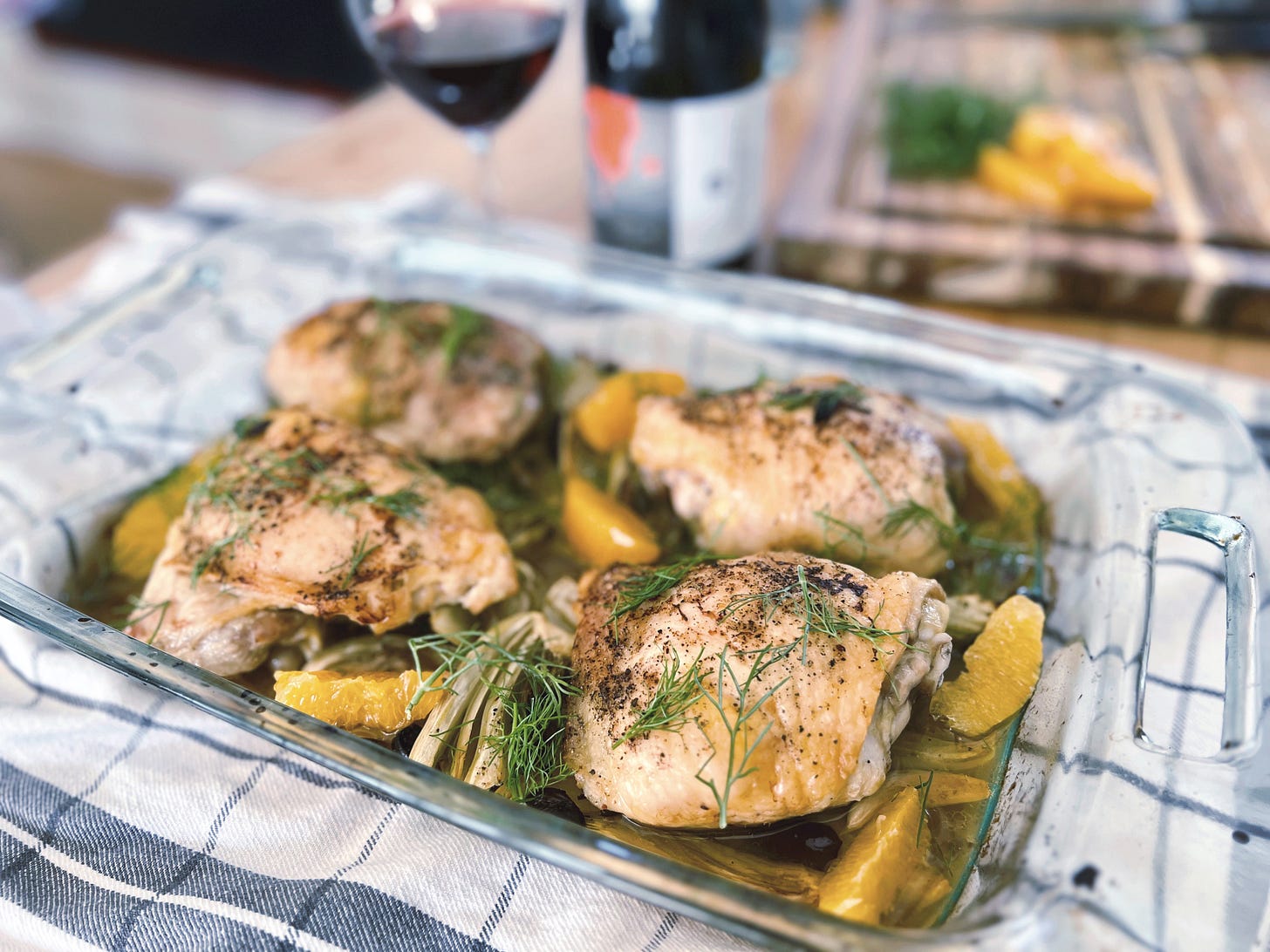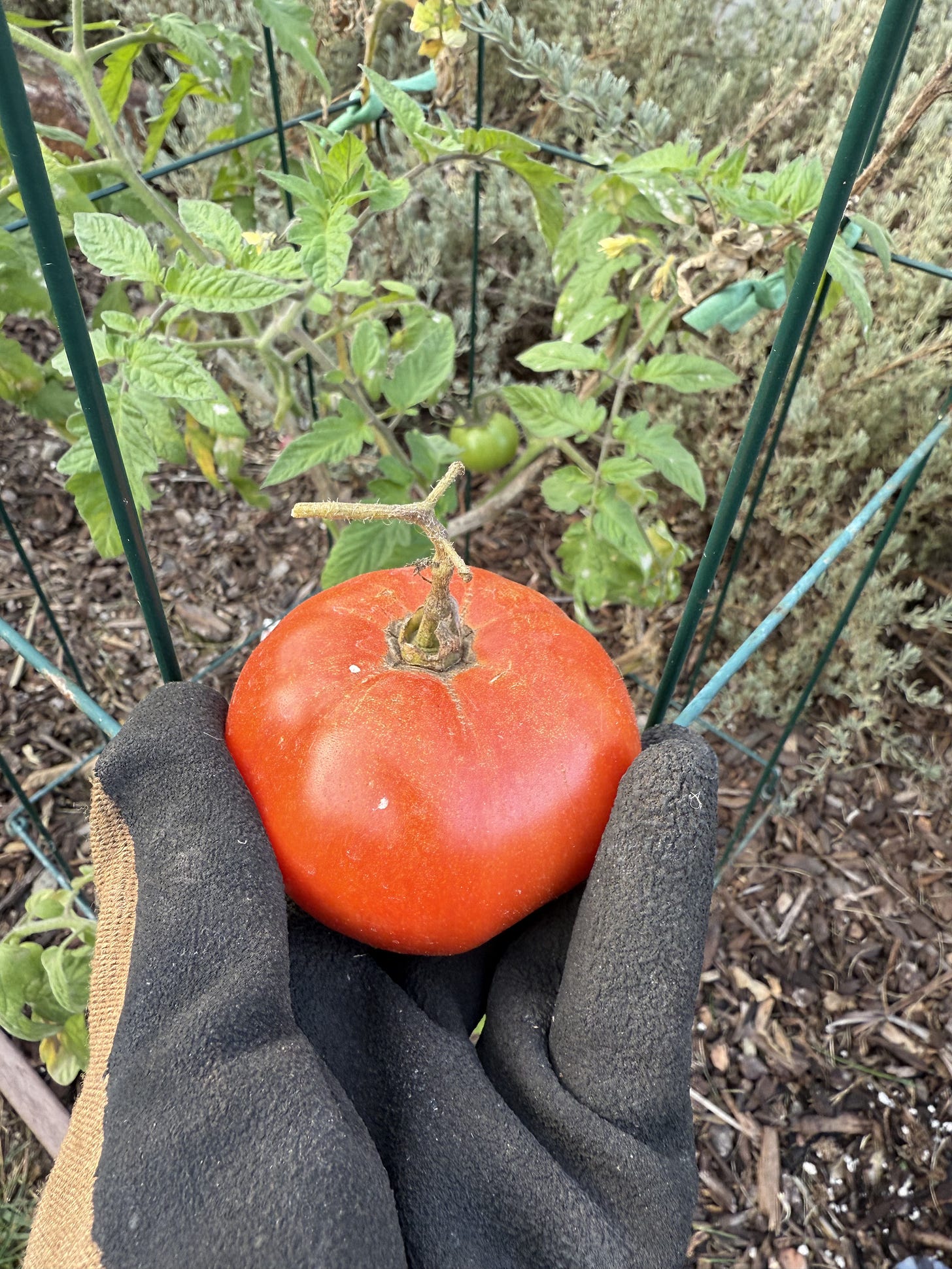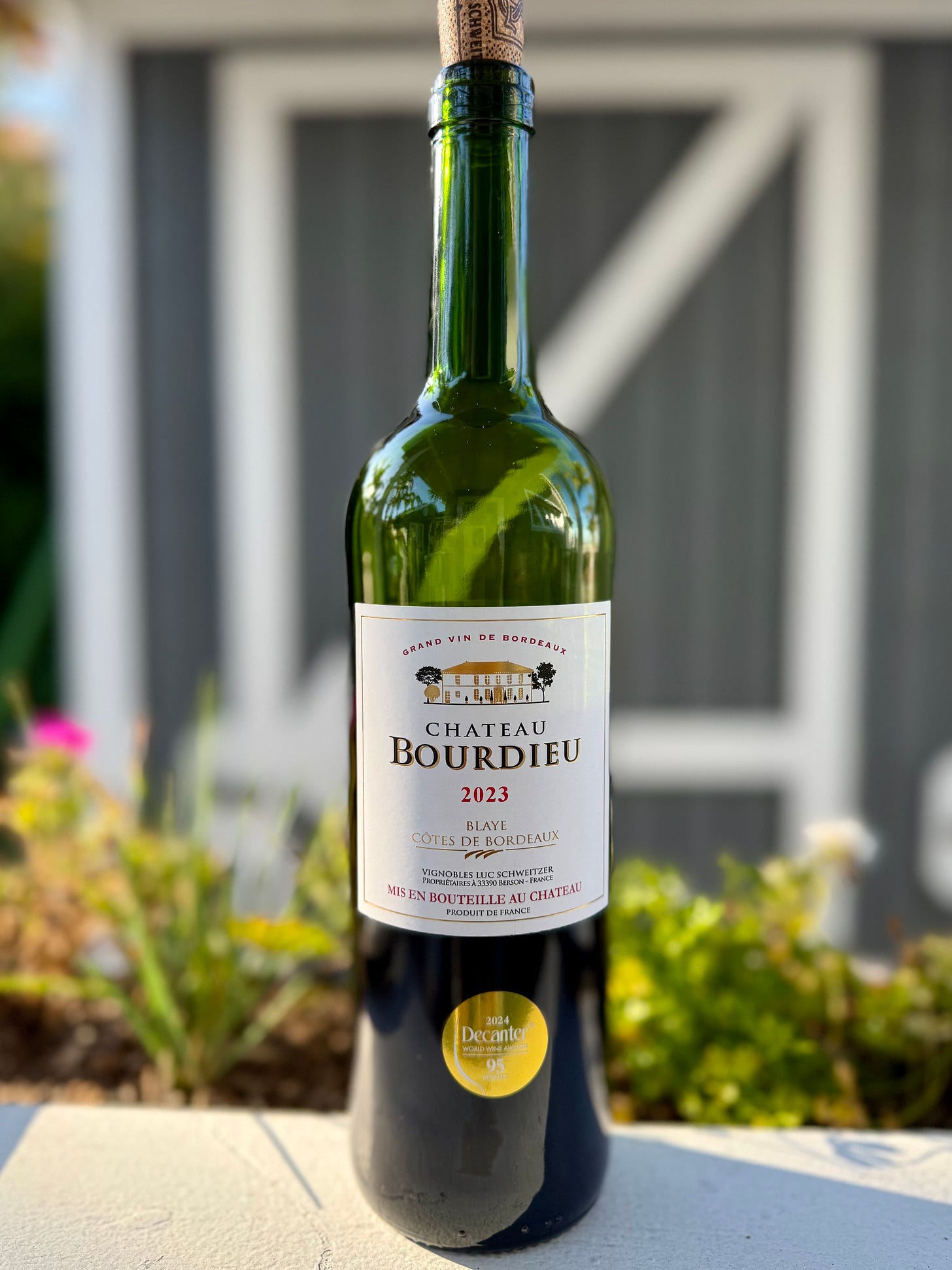Farewell Winter Garden
Meyer Lemony Broccoli and Roasted Chicken recipes + A $20, 95 point Bordeaux (for real)
My mother always says that gardening is an experiment. That these words come from a prolific and successful gardener is supposed to be a comfort when things don’t work out quite as hoped. I reached for her words many times this past winter, as I stood over a row of broccoli and cabbage plants, willing the broccoli to form a flowering head and the cabbage leaves to cohere into the central ball that makes it well, a cabbage.
It was a winter garden of colossal misses and jewel-like hits, along with some unexpected pleasures – a February tomato – that no garden plan could have predicted.
Last winter, after a crop of cauliflower was devoured by aphids while broccoli thrived right by its side, I vowed to never again plant the former and double down on the later. I planted six broccoli plants early in the fall. All grew spectacularly, a couple transforming into sapling sized stalks with broad leaves. Yet not a single one of these plants has produced the edible flowering crown that we think of as broccoli. The supermarket makes it look so easy. Meanwhile, a lone Rainbow Chard planted in a shady corner flourished, seemingly immune to pests and waving away my attentions as superfluous. It was just fine on its own, thankyouverymuch.
Looking forward to seeing many of you at our first virtual wine tasting this week with Schermeister Winery. Thank you to all those paid subscribers - including several new subscribers this past week. I appreciate your support and look forward to seeing some of you Thursday! For you wonderful free subscribers, thank you for being here, too. I hope this is place to find inpsiration for your own cooking and drinking, or just some vicarious adventures in the kitchen. If you enjoy what you read here, consider upgrading to paid to access the wine tasting recording and stay informed about events - where I hope to see you in the future!
Arugula, shallow rooted and shade-loving, has taken over a corner of the yard by a water guzzling palm tree, where nothing else will grow. Yet reliably all fall and winter, presumably all year, we can count on a large colander full of peppery leaves every three weeks. These make their way to salads, of course, but also wilted into pasta, topping pizza and even as the base for an arugula and walnut pesto, a new family favorite.
A Celebrity tomato plant survived this mild, dry winter, delivering to me one vine ripened beauty a month, a gift. I ate these gems with reverence, sliced, drizzled with olive oil and topped with flaky salt. I am told that if a tomato plant can survive the winter here in San Diego, come spring it will start producing sooner than a freshly transplanted start from the nursery. I’m nurturing this one, trimming leaves, spraying for mildew and hoping longer days will soon increase the monthly crop, maybe even enough that I’ll have tomatoes to share.
For some garden treasures, the wait is not a season, but years. As friends here have found recently with their first limes and oranges, there is a giddiness in seeing citrus fruit bud on a bush planted years ago. For us it was a Meyer lemon that I feared would never fruit and has since given us the first half dozen of what I hope will be years of this aromatic lemon. The juice has enlivened fish and transformed salad dressings, the zest has made its way into blueberry pancake batter and roasted broccoli with Pecorino, while slices have formed a natural sauce when roasted under shell-on shrimp and shishito peppers or chicken thighs and fennel.
The sun shines longer and days are warmer. It will soon be time for spring planting. I will say goodbye to those broccoli trees while wondering if this is the year for Japanese eggplant or if a Persian cucumber will take root and thrive this summer. As my mother reminds me, it won’t always work out, but when it does, the payoff – a February tomato, the first Meyer lemon on a tree planted years ago – is worth it.
Two recipes from my end of winter garden, to brighten your kitchen as we \transition to spring.
Lemon and Pecorino Roasted Broccoli
Elevate ho hum broccoli with a little lemon and minimal effort.
Serves: 4 as a side dish
Time: 25 minutes
2 heads of broccoli with stalks, about 1 lb.
3 T. olive oil
¼ tsp. black pepper, ground
2 T. grated Pecorino Romano
1 tsp. grated Meyer lemon zest
Flaky sea salt
Preheat oven to 425°F.
Cut off the stalk of the broccoli. Trim and discard end. Trim off and discard the thick outer layer of the stalk. Cut remaining tender stalk into thick match sticks about 2 inches long by ½ inch thick. For the broccoli crown, break up into florets, cutting any especially large pieces so all are roughly the same size.
Line a large baking sheet with parchment paper. Toss broccoli with olive oil and pepper to coat and lay out on the baking sheet. Roast for 20 minutes. Halfway through, pull the broccoli out and toss so browned sides are up, to evenly roast on all sides.
Once broccoli is crisp tender, remove from the oven. Sprinkle with grated Pecorino and return to the oven for two minutes until the cheese has melted. Remove from oven and scatter over lemon zest and a sprinkle of flaky sea salt.
Chicken Thighs with Melted Fennel and Winter Citrus
Serves: 4
Time: 50 minutes
1.5 kg bone-in chicken thighs
Salt
Pepper
¼ cup olive oil
2 fennel bulbs
2 Meyer lemons, skin on, thinly sliced or 2 oranges, peeled, segmented
3 cloves garlic, peeled and sliced
10 kalamata olives, pitted, sliced in half
Juice of ½ lemon
Preheat oven to 450°F. Season chicken thighs with salt and pepper and set aside while you prep the rest of the ingredients.
Trim off the fennel fronds and reserve ¼ cup, roughly chopped, for garnish. Slice fennel in half lengthwise then slice again into pieces 1 cm thick. Toss the fennel slices, Meyer lemon slices, garlic and olives with 2 T. olive oil, lemon juice, salt and pepper then spread out in a pan just large enough to hold them in a single layer (some overlapping okay) and that will fit the chicken fairly snuggly in a single layer. Place the fennel in the oven and cook for 8 minutes until just starting to brown.
Remove pan from oven and place chicken thighs on top. Drizzle over remaining 2 T. olive oil.
Return pan to oven for 10 minutes. Remove and drizzle pan juices over the chicken. Reduce oven to 425°F and return pan to oven for another 20 – 30 minutes, until chicken skin has browned and the internal temperature reaches 165°F with a thermometer and juices run clear when meat is pierced with a knife.
To serve, scatter with reserved fennel fronds. Pairs nicely with a rice pilaf, simply roasted new potatoes or crusty bread.
To Drink…
Chateau Bourdieu Blaye Cotes de Bordeaux, France 2023
I wish I could share some sunny wine news to match the bright lemon of my garden and the longer days that are upon us. Sadly, it is pretty grim. The latest round of threatened EU tariffs by the Trump administration are predicted to wipe close to $1 billion off the value of Italian wine exports globally, not to mention the effects for France, Spain, and other EU wine producers.
If the point of tariffs is to make domestically produced goods more attractive, that would require the availability of competitive alternatives. Largely the US wine industry is not structured to allow it be competitive on quality at the low to mid-tier price point of the wine market. Between the tyranny of the three-tier distribution system and the high cost of marketing and labor (which will only get worse when there are not enough migrant farm workers to harvest grapes), prices for well-made wine that tastes of place (as opposed to a laboratory) will remain high and out of reach for most drinkers. I can’t see these tariffs as a win for producers or consumers, domestically or abroad.
Locally, our favorite wine shop is for sale. After a down year for sales and two break-ins, the prospect of higher costs on European imports because of tariffs is ruinous for the business. I hope a buyer with deep pockets and good taste comes in to save the day and preserve an important local source of great wine.
But let’s end on a sunnier note. It was in that very wine shop that the owner turned us on to a 95 point rated (Decanter) Bordeaux priced at a remarkable $20 a bottle. Even when those tariffs, if imposed, make their downstream impact on consumer prices, this would still be an affordable pick. This Chateau Bourdieu Blaye Cotes de Bordeaux 2023 is made predominantly of Merlot with a modest amount of Cabernet Sauvignon and Cabernet Franc blended in. Ruby red in the glass, this bottle bursts with red currant, raspberries and blueberries. It is well structured but approachable, easy for drinking now without decanting. Stock up now and be ready to open whenever you need to be reminded of all that is great about international trade.
$19.99 at Wine Connection and other retailers










‘colossal misses and jewel-like hits’ 🤣… sounds like a lot of things in my life!